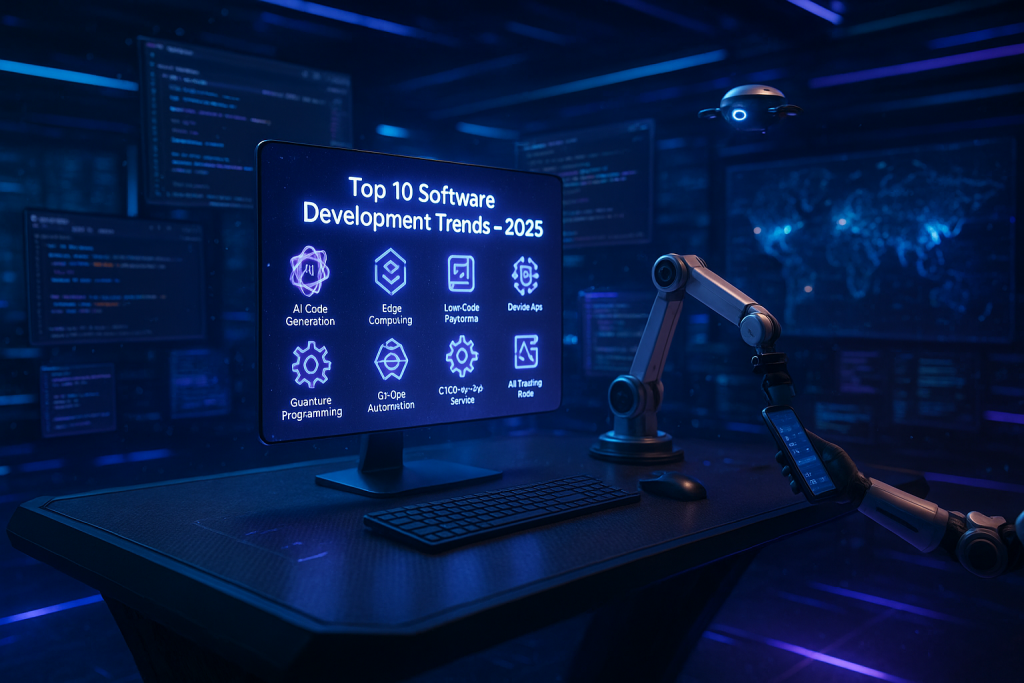
When it comes to the software world, it’s no longer about code, but it’s about intelligence, impact, and innovation. As we move into 2025, the software development industry is accelerating rapidly. Businesses are no longer asking if they need custom software; they’re asking what’s next.
From AI-powered development pipelines to low-code ecosystems, the future of software is being written in real-time. But with opportunity, there come a lot of challenges. Thus, understanding the top software development trends for 2025 is crucial for companies, developers, and digital leaders to stay ahead of the competition in this fast-evolving landscape.
So, here’s a deep dive into what’s trending, what’s transforming, and how to prepare for the new era of industrial software programming. Let’s get started!
1. AI-Driven Development: The New Standard
With emerging technologies, AI is no longer a buzzword, but it’s a core development assistant. With several tools like GitHub Copilot, ChatGPT, and Amazon CodeWhisperer, experienced developers are coding smarter, not harder.
It enhances the software development process with auto-suggestions. Moreover, it also speeds up testing, debugging, and documentation. Emerging AI trends matter because it is improving productivity while transforming the user experience in software development. That’s why you must leverage AI into your software tools.
2. Low-Code and No-Code Platforms
Today, every business wants solutions fast. Low-code and no-code platforms allow rapid prototyping and deployment without needing a full tech team. Thus, reduces time-to-market. These tools are among the powerful tools for businesses entering tech without heavy investments.
3. Cloud-Native Applications & Serverless Architecture
As digital infrastructure evolves, companies are moving from legacy systems to cloud-native models. One of the reasons is flexibility and scalability for developers and lower operational costs. Moreover, serverless is becoming the default for many who want scalability without complexity.
4. Cybersecurity-First Development
With rising cyber threats, software development services now include security as an integral layer from day one. DevSecOps is becoming mainstream. Therefore, you need to make sure to seamlessly integrate security tools and compliance-focused architecture. This shift is critical as software development industry challenges in 2025 include data breaches and AI-powered cyberattacks.
5. AI & ML Integration in Every Product
AI isn’t just powering development, but it’s being embedded directly into apps. From personalized eCommerce to predictive analytics in healthtech, emerging software technologies are making software more human-aware. AI-driven software provides real-time analytics and predictions for the ease of target users.
6. Rise of Edge Computing
As IoT devices and 5G networks expand, edge computing is gaining traction. It reduces latency and keeps processing locally for real-time applications. From autonomous vehicles to smart cities, this is a trend reshaping the latest technology in IT software.
7. Cross-Platform Development Tools
The demand for apps on every device has given rise to cross-platform tools like Flutter, React Native, and Xamarin. There are several benefits of choosing React Native for cross-platform app development. Through this, you can write once, run anywhere. It enhances efficiency in multi-platform delivery. Therefore, these are part of the new software development tools 2025 that are saving time and cost.
8. Sustainable Coding & Green Software
Climate change is pushing the tech industry to rethink energy usage. Business owners should partner with experienced developers to focus on energy-efficient coding practices and tools that monitor the carbon footprints of apps. Expect green coding to become a KPI in the software development process.
9. Hyper-Personalized Software Products
In 2025, personalization will go far beyond names on emails. Software will adapt to behavior, mood, and usage patterns in real time. There will be AI-based dynamic user journeys and intelligent automation for UX. This trend is rapidly influencing software services in demand, especially in retail, healthcare, and finance.
10. Global Software Talent Marketplaces
Remote work has opened the gates to a global talent pool. Platforms like Turing and Upwork are connecting businesses with top software developers and famous software engineers worldwide. Thus, it helps overcome local talent shortages and allows access to software development conferences and collaboration globally.
Final Thoughts
As these latest trends in software development continue to evolve, businesses must adapt quickly. The key isn’t just following trends, but understanding how these innovations in software development can be used strategically. Whether you’re looking to refine your tech stack or looking to collaborate with the top software developers, staying informed gives you a competitive edge.
The year 2025 is not just another step forward. It’s a leap into a smarter, faster, and more dynamic future. So, if you are ready to future-proof your software, then start by adopting these trends today, and do check out some more useful insights at AppFirmsReview.
FAQs
Q1. What are the key software development trends for 2025?
Top software development trends for 2025 include AI-driven development, low-code/no-code platforms, edge computing, green software, and cross-platform tools. These emerging trends focus on speed, personalization, sustainability, and automation.
Q2. What programming languages are trending in 2025?
In 2025, several languages like Python, JavaScript, Kotlin, and many more will continue to dominate due to their adaptability with AI, cloud-native systems, and cross-platform development tools like Flutter and React Native.
Q3. What does “green software development” actually mean?
Green software development focuses on creating energy-efficient code and apps that reduce carbon footprints. It aligns with sustainable tech goals and is becoming a key metric in the software development process.
Q4. What are the four main activities in software development?
The four main activities in software development are requirements analysis, design, coding (implementation), and testing. These stages form the foundation of any efficient software development lifecycle.
Q5. What is Level 4 in software development?
Level 4 typically refers to a mature software development process with managed and measurable workflows. It ensures performance is tracked and quality is consistently improved.